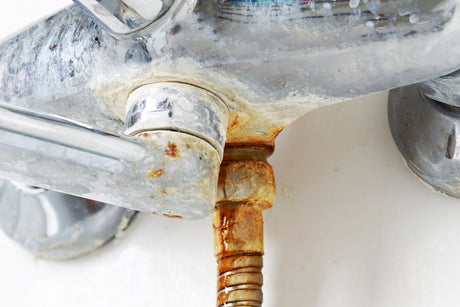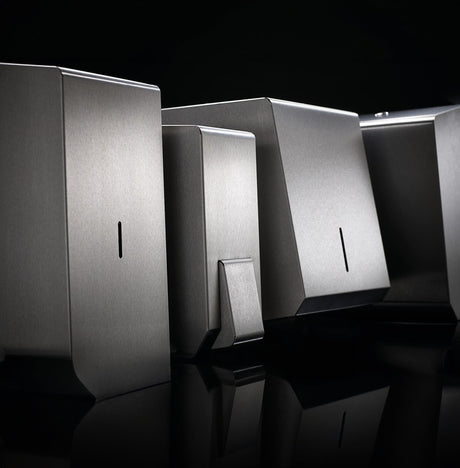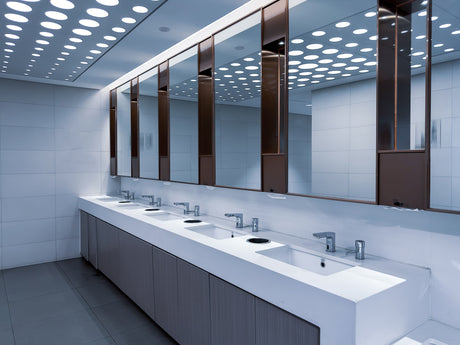When selecting hand dryers for disabled washrooms there are a number of considerations:
- Installation height
- Spray pattern of the dryer
- Wet floors
- Size of the unit
- Noise output
Installation height of hand dryers in disabled washrooms
Firstly, the height the hand dryer is installed. Disabled doesn’t necessarily mean wheelchair user, therefore there are a whole range of potential positions the users may be accessing the hand dryer from. The hand dryer will have a different recommended installation height depending on whether it is a ‘blade’ hands in hand dryer like the Dyson Airblade ; a low-energy, or a high-speed hand dryer like the Warner Howard Airforce.
Blade hand dryers are inherently more limiting for a reduced capacity user as they are intended for hands to be inserted from above for maximum effectiveness; for wheelchair users this requires extension which may or may not be possible and for a standing user will require bending.
The Mitsubishi Jet Towel is probably the best blade hand dryer for a disabled user as there is plenty of room to insert hands from the side, although this is a less effective hand drying position and may still require difficult body contortion. Blade hand drye rs are not ideal, whichever brand is chosen.
However, the major advantage is that most have a drainage system (not the Dyson Airblade) therefore prevent floors from becoming hazardous.
Spray pattern of hand dryers
Many hand dryers, most notably the Dyson V and Dyson 9kj can cause quite a lot of water spray towards the wall which means that floors and tiled walls can be Slippy. The evaopor8 splashback absorbs and dries out quickly to help overcome this problem.

Wet floors
Imagine you have difficulty balancing, the last thing you need are slippy floors. Slippy floors could mean a serious accident in a disabled and baby changing washroom. Would you really want that to happen in your premises?
A great compromise?
We would recommend the DryForce Plus hand dryer (pictured below) for disabled users. It has a relatively quick dry time, quiet in operation, is energy efficient, takes up limited space on the wall and is flexible in its location fixing. But most importantly, as you will see, has a tray at the bottom which collects water and stops it going onto the floor or over the user; if the user has parts of their body under the airflow such as when sat in a wheelchair.

Advantages and disadvantages of hands-under hand dryers in disabled washrooms
Advantages
- They have a large drying range, therefore can be accessed from a range of positions
- Sensor ranges can be adapted so they can be activated from a greater distance
Disadvanges
- Floors can be wet and slippy, this is more the case with high-speed, low-energy hand dryers that force water from the hands rather than conventional hand dryers that evaporate the moisture slowly. To overcome this issue, see the revolutionary evapor8 wall guards that soak up excess water and dry out quickly.
- High speed hand dryers may force water directly onto wheelchair users.
- Some high-speed hand dryers are very noisy and therefore would need consideration for noise sensitive users or for ear level of a wheelchair user
Depth of the hand dryer
The depth of a hand dryer in a disabled washroom is important. Disabled washrooms are designed to maximise space, therefore it is important to make the hand dryer as slimline as possible . The American Disabilities Act which is followed globally in disabled washroom design, recommends dryers that are no more than 10cm deep.
The noise of the hand dryer
A person classified as disabled may have severe sensory issues and have problems with being in loud, confined spaces. A wheelchair user or someone with a severe stoop will have their ears at a lower height, therefore a quiet hand dryer maybe even more important, especially when you consider than many disabled washrooms double up as baby changing facilities.
Summary
We wouldn’t normally say that conventional hand dryers are the best option, but for disabled toilets they may well be. They have the most accessibility, they don’t lead to such wet floors, they can have their sensor range increased and also are relatively quiet hand dryers, which is an issue if you are directly underneath the hand dryer. Can you imagine being at ear level with a Xcelerator or Dyson Airblade! Because energy-efficiency is less important in low use disabled toilets the priority has to be comfort and accessibility for a whole range of users. The Ultradry pro 1 hand dryer is an excellent value option.
To view our full range of hand dryers we recommend for disabled toilets, please click here.

———————————————–
For more information or for help in finding your ideal hand dryer, please contact us on 0114 3540047, use our contact us page or visit the homepage. Y ou can also use our Intelligent Search Tool that helps you identify the perfect dryer for your location.
In the trade? Don’t forget we can set you up with a trade account for your purchases.
We have wholesaler, contractor, public sector and charity discounts available, please don’t hesitate to ask or find out more information.






